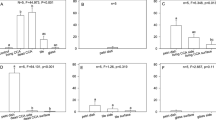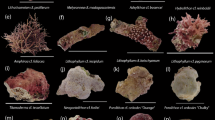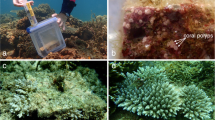Abstract
Competition for space is a major factor affecting coral survival. Since adult coral colonies are sessile, the settlement preferences of larvae have a strong impact on the competition for space that corals will face post-metamorphosis and will therefore influence long-term survival. Laboratory-based studies show that in simplified systems coral larvae use cues to guide them to suitable settlement locations, an adaptation that enhances post-settlement survival. Settlement preferences have also been reported from the field, where coral larvae encounter a wide variety of different potential settlement surfaces as the availability of free substratum (bare space) changes over time. In this field-based study, the abundance of different encrusting organisms and bare space present on settlement tiles was compared to their abundance under newly settled pocilloporid and poritid recruits, to determine if recruits choose their settlement substratum randomly. Tiles deployed for 3, 9, 12 and 15 months were used to determine if settlement choice varied as a function of benthic community successional stage. We found that pocilloporid and poritid larvae changed their settlement preference depending on the age of the benthic community they encountered. They reacted neutrally to crustose coralline algae (CCA) on tiles deployed for 3 months when bare space was abundant, but showed a clear preference for settlement on CCA on tiles deployed for 9–15 months once bare space was limited. Simultaneously, poritid recruits showed a decreasing preference over time to settle on biofilm. This change in preference is not linked to the availability of CCA because its abundance did not change significantly between tiles deployed for 3 versus 9–15 months. These results indicate that coral recruits react to several settlement cues simultaneously, guiding them to different settlement locations as the benthos changes over time. Furthermore, recruits from both families reacted similarly, suggesting that this is an evolutionarily old adaption.




Similar content being viewed by others
References
Anderson M, Gorley RN, Clarke RK (2008) Permanova + for Primer: Guide to software and statistical methods
Arnold SN, Steneck RS (2011) Settling into an increasingly hostile world: the rapidly closing “recruitment window” for corals. PLoS One 6:e28681
Arnold SN, Steneck R, Mumby PJ (2010) Running the gauntlet: inhibitory effects of algal turfs on the processes of coral recruitment. Mar Ecol Prog Ser 414:91
Babcock RC, Baird AH, Piromvaragorn S, Thomson DP, Willis BL (2003) Identification of scleractinian coral recruits from Indo-Pacific reefs. Zool Stud 42:211–226
Baird AH, Morse AN (2004) Induction of metamorphosis in larvae of the brooding corals Acropora palifera and Stylophora pistillata. Mar Freshw Res 55:469–472
Baird AH, Salih A, Trevor-Jones A (2006) Fluorescence census techniques for the early detection of coral recruits. Coral Reefs 25:73–76
Birrell CL, McCook LJ, Willis BL, Diaz-Pulido GA (2008a) Effects of benthic algae on the replenishment of corals and the implications for the resilience of coral reefs. Ocean Mar Biol Annu Rev 46:25–64
Birrell CL, McCook LJ, Willis BL, Harrington L (2008b) Chemical effects of macroalgae on larval settlement of the broadcast spawning coral Acropora millepora. Mar Ecol Prog Ser 362:129–137
Brainard R, Maragos J, Schroeder R, Kenyon J, Vroom P, Godwin S, Hoeke R, Aeby G, Moffitt R, Lammers M (2005) The state of coral reef ecosystems of the US Pacific remote island areas. The state of coral reef ecosystems of the United States and Pacific Freely Associated States. pp 338–372
Buenau KE, Price NN, Nisbet RM (2012) Size dependence, facilitation, and microhabitats mediate space competition between coral and crustose coralline algae in a spatially explicit model. Ecol Model 237–238:23–33
Clarke KR, Gorley RN (2006) PRIMER v6: User Manual/Tutorial. Primer-E Ltd, Plymouth, UK
Collen JD, Gardner JPA, Garton DW (2009) Application of the littoral cell concept to managing a protected atoll: Palmyra Atoll National Wildlife Refuge. Ocean Coast Manag 52:628–635
Connell JH (1997) Disturbance and recovery of coral assemblages. Coral Reefs 16:S101–S113
Doropoulos C, Roff G, Bozec YM, Zupan M, Werminghausen J, Mumby PJ (2016) Characterizing the ecological trade-offs throughout the early ontogeny of coral recruitment. Ecol Monogr 86:20–44
Dunstan PK, Johnson CR (1998) Spatio-temporal variation in coral recruitment at different scales on Heron Reef, southern Great Barrier Reef. Coral Reefs 17:71–81
Elmer F (2016) Factors affecting coral recruitment and calcium carbonate accretion rates on a Central Pacific coral reef. Ph.D. Thesis, Victoria University of Wellington
Elmer F, Rogers JS, Dunbar RB, Monismith SG, Bell JJ, Gardner JPA (2016) Influence of localised currents, benthic community cover and composition on coral recruitment: integrating field-based observations and physical oceanographic modelling. Proc 13th Int Coral Reef Symp 101–142
Glassom D, Zakai D, Chadwick-Furman NE (2004) Coral recruitment: a spatio-temporal analysis along the coastline of Eilat, northern Red Sea. Mar Biol 144:641–651
Golbuu Y, Richmond RH (2007) Substratum preferences in planula larvae of two species of scleractinian corals, Goniastrea retiformis and Stylaraea punctata. Mar Biol 152:639–644
Hadfield MG (2011) Biofilms and marine invertebrate larvae: what bacteria produce that larvae use to choose settlement sites. Annu Rev Mar Sci 3:453–470
Harrington L, Fabricius K, De’ath G, Negri A (2004) Recognition and selection of settlement substrata determine post-settlement survival in corals. Ecology 85:3428–3437
Heyward AJ, Negri AP (1999) Natural inducers for coral larval metamorphosis. Coral Reefs 18:273–279
Knowlton N, Jackson JBC (2008) Shifting baselines, local impacts, and global change on coral reefs. PLoS Biol 6:e54
Kohler KE, Gill SM (2006) Coral Point Count with Excel extensions (CPCe): A Visual Basic program for the determination of coral and substrate coverage using random point count methodology. Comput Geosci 32:1259–1269
Krebs CJ (1989) Ecological methodology. Harper and Row, New York
Kuffner IB, Paul VJ (2004) Effects of the benthic cyanobacterium Lyngbya majuscula on larval recruitment of the reef corals Acropora surculosa and Pocillopora damicornis. Coral Reefs 23:455–458
Kuffner IB, Walters LJ, Becerro MA, Paul VJ, Ritson-Williams R, Beach KS (2006) Inhibition of coral recruitment by macroalgae and cyanobacteria. Mar Ecol Prog Ser 323:107–117
Mangubhai S, Harrison PL, Obura DO (2007) Patterns of coral larval settlement on lagoon reefs in the Mombasa Marine National Park and Reserve, Kenya. Mar Ecol Prog Ser 348:149–159
Manica A, Carter R (2000) Morphological and fluorescence analysis of the Montastrea annularis species complex in Florida. Mar Biol 137:899–906
Manly BFJ, Miller P, Cook LM (1972) Analysis of a selective predation experiment. Am Nat 719–736
Mason B, Beard M, Miller MW (2011) Coral larvae settle at a higher frequency on red surfaces. Coral Reefs 30:667–676
Morse DE, Hooker N, Morse ANC, Jensen RA (1988) Control of larval metamorphosis and recruitment in sympatric agariciid corals. J Exp Mar Biol Ecol 116:193–217
Morse AN, Iwao K, Baba M, Shimoike K, Hayashibara T, Omori M (1996) An ancient chemosensory mechanism brings new life to coral reefs. Biol Bull 191:149–154
O’Leary JK, Potts DC, Braga JC, McClanahan TR (2012) Indirect consequences of fishing: reduction of coralline algae suppresses juvenile coral abundance. Coral Reefs 31:547–559
Piniak GA, Fogarty ND, Addison CM, Kenworthy WJ (2005) Fluorescence census techniques for coral recruits. Coral Reefs 24:496–500
Prescott RD (2015) Water quality influences on declining coral settlement from the Great Barrier Reef region: biofilms as key players. Ph.D. thesis, University of Hawai’i at Manoa
Price N (2010) Habitat selection, facilitation, and biotic settlement cues affect distribution and performance of coral recruits in French Polynesia. Oecologia 163:747–758
Price NN, Martz TR, Brainard RE, Smith JE (2012) Diel variability in seawater pH relates to calcification and benthic community structure on coral reefs. PloS One 7:e43843
Ritson-Williams R, Arnold SN, Fogarty ND, Steneck RS, Vermeij MJ, Paul VJ (2009) New perspectives on ecological mechanisms affecting coral recruitment on reefs. Smithson Contrib Mar Sci 38:437–457
Ritson-Williams R, Paul VJ, Arnold SN, Steneck RS (2010) Larval settlement preferences and post-settlement survival of the threatened Caribbean corals Acropora palmata and A. cervicornis. Coral Reefs 29:71–81
Ritson-Williams R, Arnold SN, Paul VJ, Steneck RS (2014) Larval settlement preferences of Acropora palmata and Montastraea faveolata in response to diverse red algae. Coral Reefs 59–66
Ritson-Williams R, Arnold SN, Paul VJ (2016) Patterns of larval settlement preferences and post-settlement survival for seven Caribbean corals. Mar Ecol Prog Ser 548:127–138
Roth MS, Knowlton N (2009) Distribution, abundance, and microhabitat characterization of small juvenile corals at Palmyra Atoll. Mar Ecol Prog Ser 376:133–142
Salih A, Larkum A, Cox G, Kuhl M, Hoegh-Guidberg O (2000) Fluorescent pigments in corals are photoreceptive. Nature 408:850
Sandin SA, Smith JE, DeMartini EE, Dinsdale EA, Donner SD, Friedlander AM, Konotchick T, Malay M, Maragos JE, Obura D (2008) Baselines and degradation of coral reefs in the northern Line Islands. PLoS One 3:e1548
Tran C, Hadfield MG (2011) Larvae of Pocillopora damicornis (Anthozoa) settle and metamorphose in response to surface-biofilm bacteria. Mar Ecol Prog Ser 433:85–96
Tsuda RT, Fisher JR, Vroom PS (2012) Floristic account of the marine benthic algae from Jarvis Island and Kingman Reef, Line islands, Central Pacific. Micronesica 43:14–50
Vargas-Angel B (2009) Coral health and disease assessment in the US Pacific remote island areas. Bull Mar Sci 84:211–227
Vargas-Ángel B (2010) Crustose coralline algal diseases in the U.S.-affiliated Pacific Islands. Coral Reefs 29:943–956
Vermeij MJA, Delvoye L, Nieuwland G, Bak RPM (2002) Patterns in fluorescence over a Caribbean reef slope: the coral genus Madracis. Photosynthetica 40:423–429
Vermeij MJA, Sandin SA (2008) Density-dependent settlement and mortality structure the earliest life phases of a coral population. Ecology 89:1994–2004
Webster NS, Smith LD, Heyward AJ, Watts JEM, Webb RI, Blackall LL, Negri AP (2004) Metamorphosis of a scleractinian coral in response to microbial biofilms. Appl Environ Microbiol 70:1213–1221
Webster FJ, Babcock RC, Van Keulen M, Loneragan NR (2015) Macroalgae inhibits larval settlement and increases recruit mortality at Ningaloo Reef, Western Australia. PloS One 10:e0124162
Williams GJ, Aeby GS, Davy SK (2008a) Coral disease at Palmyra Atoll, a remote reef system in the Central Pacific. Coral Reefs 27:207
Williams GJ, Maragos JE, Davy SK (2008b) Characterization of the coral communities at Palmyra Atoll in the remote Central Pacific Ocean. National Museum of Natural History, Smithsonian Institution, Washington, D.C., USA
Williams GJ, Smith JE, Conklin EJ, Gove JM, Sala E, Sandin SA (2013) Benthic communities at two remote Pacific coral reefs: effects of reef habitat, depth, and wave energy gradients on spatial patterns. PeerJ 1:e81
Work TM, Aeby GS, Maragos JE (2008) Phase shift from a coral to a corallimorph-dominated reef associated with a shipwreck on Palmyra Atoll. PLoS One 3:e2989
Acknowledgements
This research was supported by the Gordon and Betty Moore Foundation (USA) and by a Victoria University of Wellington Doctoral Scholarship from Victoria University of Wellington (to FE) and was carried out as part of The Reefs Tomorrow Initiative (http://reefstomorrowinitiative.org/). We thank The Nature Conservancy and the US Fish and Wildlife Service for access to Palmyra Atoll for fieldwork and for their help in the field. We also thank Holly Bennett, Charlie Clark, Alex Laferriere and Eva Schemmel for help with fieldwork and David Young for illustrations.
Author information
Authors and Affiliations
Corresponding author
Additional information
Topic Editor Dr. Anastazia Banaszak
Rights and permissions
About this article
Cite this article
Elmer, F., Bell, J.J. & Gardner, J.P.A. Coral larvae change their settlement preference for crustose coralline algae dependent on availability of bare space. Coral Reefs 37, 397–407 (2018). https://doi.org/10.1007/s00338-018-1665-2
Received:
Accepted:
Published:
Issue Date:
DOI: https://doi.org/10.1007/s00338-018-1665-2




